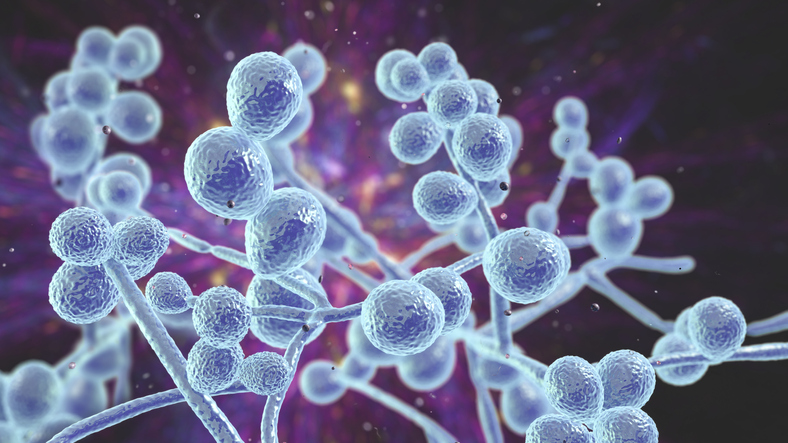The gut microbiome has been increasingly connected to a myriad of conditions, in part due to the metabolic output of the microbes in the gut. Studies have suggested that exposure to carcinogens or toxins can have a broader impact on health. The brain-gut microbiome connection has also been under investigation. How the gut microbiome impacts the brain’s response to and preference for alcohol has not yet been thoroughly explored.
Researchers at Tufts University have found a connection between a gut fungus, Candida albicans, and the dopamine pathway in the brain. Their paper titled, “Candida albicans colonization modulates murine ethanol consumption and behavioral responses through elevation of serum prostaglandin E2 and impact on the striatal dopamine system,” was published in mBio.
C. albicans is a fungal member of the gut microbiome, often undergoing growth blooms in response to stressors including antibiotic use, poor diet, and alcohol consumption. During these fungal blooms, it produces prostaglandin E2 (PGE2), which, upon entering the brain, can alter the dopamine signaling pathway.
As prior research in humans shows C. albicans blooms in individuals with alcohol use disorder (AUD), the researchers hypothesized that elevated levels of PGE2 would lead to increased preference for alcohol, and therefore increased alcohol use. To test this, they orally inoculated mice with C. albicans, evaluating them for PGE2 serum levels and alcohol preference. Surprisingly, though the inoculated mice had increased levels of PGE2, they showed a reduced affinity to alcohol use. When the PGE2 receptor was blocked, the behavior reversed.
“Alcohol is an extremely effective anxiety-reducing drug. Therefore, we thought that C. albicans colonization in mice would increase alcohol consumption and were surprised to find that it actually reduced it in our model,” senior author Carol Kumamoto, PhD, professor of molecular biology and microbiology at the Tufts University School of Medicine and first author Andrew Day, PhD, former doctoral student at Tufts Graduate School of Biomedical Sciences shared with GEN.
While many treatments for AUD hinge on behavioral modifications, exploration of alternative approaches, including therapies involving the gut microbiome, may be a promising path. “We are excited to learn more about the mechanisms that allow microbes to affect host behavior,” shared Kumamoto and Day with GEN.
GEN spoke in more detail with Kumamoto and Day about their research.
This interview has been edited for length and clarity.
GEN: Why is it important to study the gut microbiome and its interactions with the rest of the body?
Kumamoto and Day: The gut microbiome is, in a sense, an organ that has long been neglected in scientific research due to an inability to accurately study its composition and/or function. The gut microbiome has many important roles in health and disease, such as the production of short-chain fatty acids needed for colonic health, the production of neurotransmitters that contribute to the enteric nervous system, stimulation of the immune system, as well as countless other functions.
These functions of the microbiome have extremely profound consequences to the host when there is dysbiosis or improper function of this organ. These consequences include contributions to diseases/disorders ranging from autism to cancer to depression to AUD. Figuring out how the gut microbiome contributes to these various disorders and diseases is important to gain a comprehensive picture of therapeutic targets for diseases and to further our understanding of this organ.
GEN: What was the drive behind beginning this project?
Kumamoto and Day: We had previously shown that C. albicans colonization in mice impacts host molecules called endocannabinoids and spurs an anxiety-like phenotype. Along with this, work largely done by Bernd Schnabl’s lab at the University of California, San Diego, demonstrated that C. albicans shows increased abundance in fecal samples from individuals with AUD and can contribute to the progression of alcoholic liver disease. These observations led us to wonder whether there are impacts of C. albicans colonization on phenotypes that drive AUD.
GEN: Were there any significant challenges you faced in your work on this project?
Kumamoto and Day: Yes, we struggled to find the connection with PGE2. It was challenging to home in on this molecule, but we were aided by some research from 1990, which stimulated us to conduct our own studies and focus on this interesting molecule.
GEN: You got a result that was unexpected based on your initial hypothesis. Can you explain a bit about why you made the initial hypothesis and what happened when you got the results of your experiments? Why was the result unexpected?
Kumamoto and Day: We imagined a picture where C. albicans colonization would increase alcohol consumption because C. albicans is found at higher concentrations in the gastrointestinal tract of individuals with AUD, and C. albicans colonization stimulates anxiety-like phenotypes in mice.
The important caveats are that these are ethanol naïve mice, and we are using a short-term colonization model. There could be a different effect of C. albicans in individuals with AUD. This is an interesting question for future research.
GEN: Were there any other interesting or unexpected results from this project?
Kumamoto and Day: We were surprised by how quickly C. albicans affects murine behavior, in this case, alcohol consumption. Effects on consumption were observed within 24 hours of inoculating mice with C. albicans. We were also very surprised that C. albicans colonization affected mouse intoxication. The observation that colonized mice exhibited greater loss of motor coordination with equivalent doses of alcohol was very surprising and exciting.
GEN: What are you looking forward to in the next steps of this research?
Kumamoto and Day: We are excited to learn more about the mechanisms that allow microbes to affect host behavior. Furthermore, determining if other microbes affect PGE2 to impact ethanol consumption or if other eicosanoids related to PGE2 also impact addiction-related behaviors will be very important to gain a more comprehensive understanding of addiction.

